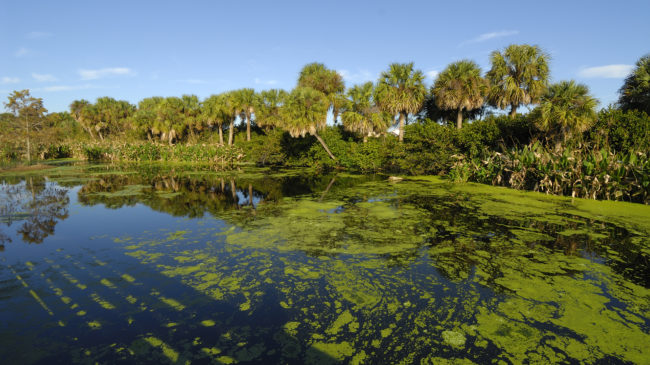The coronavirus pandemic is rattling Florida’s economy and the state’s tourism industry is among the sectors hardest hit by reduced travel and local lockdowns. The most recent data released from the Florida Department of Economic Opportunity indicates that the leisure and hospitality industry lost 268,000 jobs in June, down 21.5 percent compared to last year. This decline is particularly problematic for the state considering Florida’s reliance on sales tax revenue that is generated from tourist activity.
As the state considers its response to the pandemic and how it can help the tourism industry recover, it should ensure that another problem does not further deter visitors from going to Florida’s legendary waterways.
Florida has recently suffered from a wave of blue-green algae blooms triggered by nutrient pollution from urban and agricultural sources. In addition to killing wildlife, the algae present health hazards to humans including irrigation the gastrointestinal tract, liver, nervous system, and skin. Some research even links long-term exposure to the development of neurodegenerative disorders like Amyotrophic Lateral Sclerosis (ALS) and Alzheimer’s disease.
Blooms in 2016 and 2018 were severe enough to cause states of emergency to be declared, generating negative headlines across the country, something Florida can hardly afford over the next few years as it tries to recover from the current recession.
At the center of Florida’s water quality issues: Lake Okeechobee and the wider Everglades region. Starting in Central Florida, nutrients (nitrogen and phosphorous) flow through the Kissimmee River and into Lake Okeechobee. Historically, water would spill over the southern end of the lake before flowing through Everglades to the southern end of the Florida Peninsula. The water was naturally filtered as nutrients were taken up by a vast “river of grass,” giving rise to one of the most diverse ecosystems on the planet.
U.S. Army Corps of Engineers
Beginning in the 1850s, a series of drainage and infrastructure projects altered the natural flow of water to make way for human settlements. Today, a network of over 2,200 miles of canals and 2,100 miles of levees operated by the South Florida Water Management District (SFWMD) blocks water from flowing south of Lake Okeechobee. While this infrastructure provides flood control for millions of Florida residents and has enabled tremendous economic growth, it results in enormous quantities of nutrient-laden water being flushed to the coasts each year. This flow of nutrients fuels blooms along the Caloosahatchee and St. Lucie rivers, damaging local economies, and driving away visiting anglers.
After recognizing the harmful effects of altering the natural flow of water through the Everglades, Congress authorized the Comprehensive Everglades Restoration Plan (CERP) in 2000. Widely regarded as the single largest ecosystem restoration plan in the world, the strategy consists of massive infrastructure projects with construction timelines spanning decades. Thus far, state and federal authorities have spent nearly $4 billion restoring wetlands and constructing massive water storage and treatment infrastructures. Despite the scale of these investments, the majority of the 50+ projects planned under CERP are far from complete.
The most immediate action Florida can pursue to address the issue is to expedite restoration efforts and invest in improved water quality monitoring. There are currently insufficient systems in place to determine the impact of completed projects, engage in strategic project selection, and assess progress toward water quality goals. Developing a more robust monitoring program would help achieve these goals while making the most effective use of scarce state resources.
In the longer term, Florida must address agricultural and urban sources of nutrient pollution. Agricultural runoff, primarily from dairies and pastures north of Lake Okeechobee, is the largest source of nutrient pollution the causes algal blooms. Producers in the Okeechobee watershed are currently required to either implement “Best Management Practices” developed by the Florida Department of Agriculture and Consumer Services to reduce runoff or demonstrate that they are meeting water quality standards.
According to SFWMD, Best Management Practices resulted in a 70 percent phosphorus reduction south of Lake Okeechobee in 2017. However, environmental groups challenge these figures because SFWMD relies on best-case-scenario modeling to produce the estimates. Improved water quality data and monitoring would provide greater clarity as to the effectiveness of Best Management Practices and help identify areas for further improvement.
In urban areas, wastewater runoff from failing septic systems and overwhelmed sewer systems also contributes to the problem. Many of Florida’s estimated 2.6 million septic systems will need to be replaced or converted to sewer systems in the coming years. This will come at a great financial cost to households and municipal governments. As more homes are connected to sewer systems, additional investments will be required to expand system capacities. So that infrastructure investments can be more targeted improved monitoring would help form a more accurate picture of the areas where wastewater contributes to nutrient pollution most heavily.
Avoiding severe blue-green algae blooms will be essential to Florida’s economic recovery from the current recession. While substantial restoration efforts began two decades ago, there is still much progress to be made. Investing in better water quality monitoring will help accomplish the short-term goal of expediting key infrastructure projects while also informing evidence-based decision-making in the longer term.


